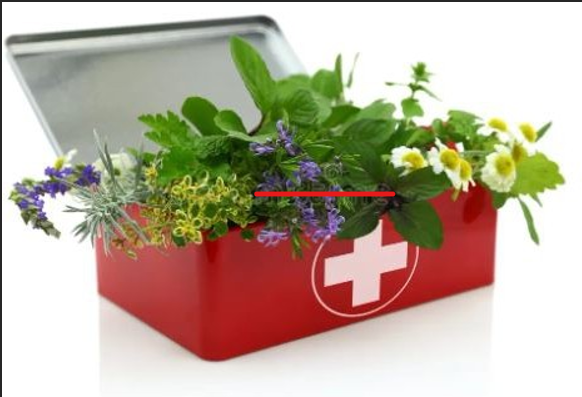Updates
Creating an Herbal First Aid Kit for Outdoor Adventures
When venturing into the great outdoors during the summer months, it’s essential to be prepared for any injuries or discomfort that may arise. While traditional first aid supplies are a must, integrating herbs into your first aid kit can provide a natural and effective way to address common summer-related injuries such as cuts, bug bites, poison ivy, and heat exhaustion. In this article, we will explore essential herbs and their applications for these ailments, and provide tips for assembling a portable herbal first aid kit.
Cuts and Wounds:
Aloe Vera: Known for its soothing properties, aloe vera gel can be applied topically to minor cuts and burns. It helps reduce inflammation, promotes healing, and relieves pain.
Calendula: With its antimicrobial and anti-inflammatory properties, calendula salve or cream can aid in the healing process of wounds and cuts. It helps prevent infection and reduces swelling.
Bug Bites and Stings:
Lavender: Lavender essential oil possesses analgesic and anti-inflammatory properties, making it an excellent remedy for soothing insect bites. It relieves itching and reduces inflammation.
Plantain: The leaves of the plantain herb can be crushed and applied to insect bites or stings to relieve itching and reduce swelling. Its natural antimicrobial properties can also help prevent infection.
Poison Ivy, Oak, and Sumac:
Jewelweed: Found in many wooded areas, jewelweed is known for its effectiveness in treating poison ivy, oak, and sumac rashes. The juice from the plant’s stem or leaves can be applied topically to relieve itching and inflammation.
Chamomile: Chamomile’s anti-inflammatory properties can help soothe irritated skin caused by contact with poisonous plants. A chamomile tea bag can be steeped in hot water, cooled, and then applied as a compress to the affected area.
Heat Exhaustion:
Peppermint: Peppermint tea or oil can be beneficial for combating heat exhaustion. Its cooling properties help reduce body temperature, alleviate headaches, and relieve nausea.
Yarrow: Yarrow is a natural diaphoretic, meaning it promotes sweating, which aids in cooling down the body. It can be prepared as a tea or tincture to help alleviate symptoms of heat exhaustion.
Tips for Assembling a Portable Herbal First Aid Kit:
* Research and gather your herbs: Learn about the herbs mentioned above and their various applications. Purchase or harvest the herbs, ensuring they are sourced from reliable and reputable
* Prepare herbal remedies: Create salves, creams, or tinctures using the herbs that you’ve gathered. Ensure proper labeling and storage to maintain freshness and
* Include basic first aid supplies: Don’t forget to include traditional first aid supplies such as bandages, antiseptic wipes, tweezers, and scissors in your These items are essential for wound care.
* Choose suitable containers: Opt for portable and durable containers to hold your herbal first aid Consider using small glass jars, metal tins, or plastic containers
with secure lids to prevent spillage.
* Include instructions: Include clear instructions on how to use each herbal remedy in your This will be useful for both yourself and others who may need to access your first aid supplies.
* Store safely: Store your herbal first aid kit in a cool, dry place to maintain the potency of the Avoid exposure to direct sunlight or extreme temperatures.
* Educate yourself: Take the time to educate yourself on basic first aid techniques and when it is appropriate to use herbal remedies. Knowing when to seek professional medical help is crucial in emergency
By creating an herbal first aid kit for your outdoor adventures, you can have a natural and effective solution at your fingertips for common summer-related injuries. However, it’s important to remember that herbal remedies should complement, not replace, professional medical care when necessary.
* Personalize your kit: Consider your specific needs and outdoor activities when assembling your herbal first aid kit. If you’re prone to allergies or have pre- existing medical conditions, consult with a healthcare professional or herbalist to determine which herbs are safe and suitable for you.
* Research local herbs: If you’re exploring a new area, take the time to research local herbs that can be useful for first aid. Learning about native plants and their medicinal properties can help you utilize natural resources readily available in the
* Stay informed and update your kit: Keep up-to-date with your knowledge of herbs and their uses. As you gain more experience and encounter different situations, you may discover new herbs or remedies to include in your herbal first aid kit. Regularly check the expiration dates of your herbal preparations and replace them as
Remember, while herbal remedies can provide relief for minor injuries, it’s crucial to seek professional medical attention for more severe conditions or if symptoms persist or worsen.
Creating an herbal first aid kit for outdoor adventures is a proactive step towards embracing the healing power of nature. By harnessing the properties of essential herbs, you can address common summer-related injuries such as cuts, bug bites, poison ivy, and heat exhaustion in a natural and holistic way. With careful research, preparation, and knowledge, your portable herbal first aid kit will become a trusted companion on your outdoor escapades, promoting wellness and well-being amidst the beauty of nature.



















